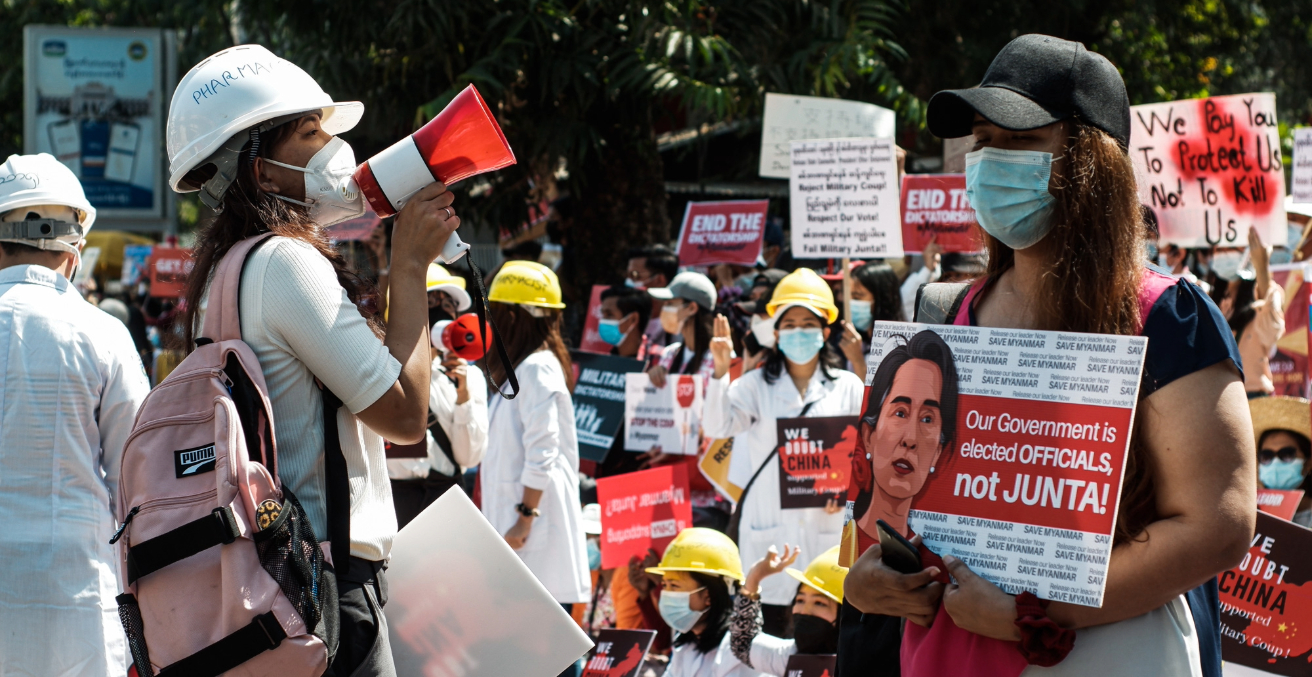Latin America has been vastly impacted by COVID-19. Will high vaccination rates be enough to curb the effect of the pandemic?
Latin America is deemed by many as the epicentre of the COVID-19 pandemic. Figures from the Johns Hopkins Coronavirus Resource Centre show that Brazil has the second-highest number of cases worldwide. With 22,017,276 cases and 612,659 deaths, Brazil is now ahead of India and only just behind the US. Mexico, with 3,863,362 cases and 465,911 deaths, is the fourth-worst hit country in the world. Peru, with 2,224,344 cases and 200,866 deaths, is the sixth-worst affected globally. Peru also has the highest number of COVID-19 related deaths per capita in the world.
The high infection rates and COVID-19-related deaths in Brazil and other Latin American countries have been raising concerns in the international community about future security developments, both in the region and globally. Brazil’s out-of-control pandemic, and Mexico’s elevated infection rates and deaths, can be attributed to the sluggish responses of populist leaders during the onset of the greatest health crisis of this generation. Brazil’s far-right president, Jair Bolsonaro, infamously deemed the coronavirus a “little flu,” and he refuses to comply with the mask-wearing guidelines of the World Health Organization. Mexico’s left-leaning populist president, Andrés Manuel López Obrador, has also downplayed the threat posed by the virus, stating in the early stages of the pandemic, “If you can do it and have the economic capacity, continue to take your family out to eat at restaurants because this strengthens the local economy.”
Despite a turbulent start in the fight against COVID-19, Latin American countries currently have promising vaccine rollouts. Chile has 82 percent of its population immunised, followed by Cuba with 80 percent, Uruguay with 75 percent, Brazil with 60 percent, and Mexico, which has 49 percent of the population is fully inoculated. However, Latin America continues to be a COVID-19 hotspot, thereby increasing the risk of new variants emerging which could threaten strategies to clamp down the virus both regionally and globally.
High Immunisation Rates in Latin America: A Sign of Hope or Too Little Too Late?
Although there were initial setbacks in regional vaccination rollouts, Latin America’s vaccination programs can be seen as success stories, with over 50 percent of the population immunised in countries across the region. However, political leaders’ views and vaccine diplomacy have played a central role in impeding the implementation of inoculation programs across the region.
In the case of Brazil, President Bolsonaro played down the threat posed by the virus, agitating his support base in anti-lockdown protests which morphed into anti-democracy protests. Since the beginning of the pandemic, Bolsonaro has intensified his attacks towards Brazilian institutions and Supreme Court, raising fears for Brazil’s democratic future. Recently, Bolsonaro declared that the immunisation program makes no sense, giving ammunition to anti-vax supporters in the region and around the world. Bolsonaro’s former minister for foreign affairs, Ernesto Araújo, also made disparaging remarks about Chinese influence in the world. In his blog Metapolitica, Araújo stated that the COVID-19 crisis is part of a Chinese conspiracy for world domination. Brazil-China relations soured in early 2021 due to Araújo’s posturing and Bolsonaro’s previous anti-China remarks, causing significant delays for the arrival of Chinese immunisation products in Brazil. In order to patch up the relationship, Bolsonaro reshuffled his cabinet, appointing Carlos Alberto França as the new minister for foreign affairs, softening the administration’s anti-China narrative. Brazil is also currently developing CoronaVac vaccines domestically at the Instituto Butantan in SãoPaulo.
Mexico’s response to the pandemic was affected by populist President López Obrador’s critical views of state-led lockdowns, which compromised the country’s ability to control COVID-19 numbers. Obrador’s ineffective response to the pandemic crushed his approval rates last year, and consequently, Obrador softened his anti-lockdown approach. Recently, however, Obrador criticised Europe’s “excessive” anti-COVID-19 measures, deeming them “authoritarian.” His views thus can be an impediment to Mexico’s strategy in the pandemic. In October 2021, Mexico received six million AstraZeneca and 6.5 million Sputnik V vaccines, alongside increasing international pressure for a successful national vaccine rollout. The Mexican government has yet to introduce an inoculation program for children, with minors currently flying to the US to get their vaccines.
Although not impacted by anti-lockdown populist views, Peru’s structural inequalities are a notable obstacle in the fight against COVID-19. Peru’s vulnerability has multiple causes, including a deficient healthcare system and a majority of the population – 68 percent of its national labour force – earning their income through the informal economy. This creates additional challenges to state-led lockdowns, as well as social distancing. Another challenge in the fight against COVID-19 in Peru is the absence of financial support to those worst hit by the crisis. Peru began its vaccination rollout amidst the country’s second wave in mid-February 2021, with President Francisco Sagasti rolling up his sleeves and getting jabbed to encourage mass immunisation. Countries such as the US started rolling out vaccines in early December 2020, nearly two months earlier than most developing nations. Global North nations secured vaccines months in advance of Latin American countries and other parts of the developing world, widening the gap between the world’s wealthiest countries and the poorest of the poor.
Can High Levels of Immunisation Slow Down the Pandemic?
The pandemic is bound to accelerate again in the Americas and in countries such as Brazil, despite high levels of immunisation. Fears of a new surge of COVID-19 cases in the region have lead Mexico’s López Obrador to reconsider the need for a third immunisation booster dose across the country. But is mass inoculation the only way out of the crisis?
The logistics of rolling out an effective immunisation program in Latin America would be a major undertaking, with the implementation of a mandatory third dose and follow up booster doses seeming like a herculean task. The pathway to having over 90 percent of the population immunised is thus not likely to be straightforward. Another force multiplier to the challenges faced by Latin America are far-right, anti-vax views, which deem the immunisation program to be a globalist conspiracy and the origins of COVID-19 to be a Chinese plot for world domination. Such views pose a threat not only to the successful immunisation of the continent, but also to neighbouring countries and all nations worldwide.
As new variants of COVID-19 such as the Delta strain and the Omicron strain spread, countries must create specific strategies to subdue the virus. If Latin America leaders understood the magnitude of the public health tsunami about to hit their nations and acted swiftly to control case numbers, the continent would have a better chance in the fight against COVID-19.
Populist leaders and political stunts, however, have paved the way for an out-of-control pandemic. High vaccination rates may assist in curbing the soaring numbers of cases, but vaccination alone doesn’t make its citizens bulletproof. The regular use of masks and public health measures, such as small-scale but more regular lockdowns, could help in the fight against the virus.
In Latin America, one of the parts of the world with vast levels of inequality, unleashing a pandemic disproportionally affects the livelihoods of the economically vulnerable. Brazil’s Instituto Fio Cruz, for instance, is increasingly concerned with the lack of resources in public hospitals. The people living in favelas depend on tokenistic and underfunded public health systems, which lack basic pharmaceutics and equipment. The few that are available are likely to collapse if the pandemic accelerates once again.
The pandemic magnifies the daily challenges faced by the poor – who are working with no job security – which in turn increases the risk of food insecurity and jeopardises their basic human rights. There are never easy solutions for complex problems, however regional leaders ought to put aside the politics of self-interest and populism and focus on articulating a regional strategy in the fight against COVID-19. This can pave the way for regional cooperation, and eventually even a global strategy.
This piece is based on the discussion panel COVID-19 Diplomacy, in a presentation titled: Latin America’s Responses to the Pandemic: Implications to Regional and Global Security, presented at the European Studies Association Australia and New Zealand (ESAANZ) and the Australian Association for Communist and Post-communist Studies (AACAPS) Conference 2021, hosted virtually 25-26 November 2021 by RMIT University in Melbourne.
Flavia Bellieni Zimmermann is a Teaching Fellow and Doctoral Candidate in Political Science and International Relations at the University of Western Australia. She holds a Bachelor of Laws with First Class Honours from the Pontifical Catholic University in Rio de Janeiro and a Graduate Diploma of International Relations and Security Studies from Curtin University, Western Australia. She is a Brazilian political analyst and has written extensively in this field. Her research interests include Brazilian politics and society, Latin American politics, populism and nationalism, women in the global south, gender, politics and religion.
This article is published under a Creative Commons Licence and may be republished with attribution.




